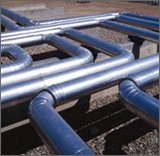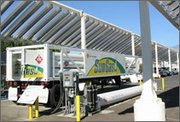Hydrogen delivery (Energy)
Contents
- 1 Hydrogen delivery
- 1.1 Introduction Light-duty vehicle at hydrogen refueling station. Infrastructure is required to move hydrogen (Hydrogen delivery) from the location where it's produced to the dispenser at a refueling station or stationary power site. Infrastructure includes the pipelines, trucks, railcars, ships, and barges that deliver fuel, as well as the facilities and equipment needed to load and unload them.
- 1.2 Central Versus Distributed Production
- 1.3 Delivery Modes
- 1.4 Further reading
Hydrogen delivery
Introduction Light-duty vehicle at hydrogen refueling station. Infrastructure is required to move hydrogen (Hydrogen delivery) from the location where it's produced to the dispenser at a refueling station or stationary power site. Infrastructure includes the pipelines, trucks, railcars, ships, and barges that deliver fuel, as well as the facilities and equipment needed to load and unload them.
Delivery technology for hydrogen infrastructure is currently commercially available and several U.S. companies deliver bulk hydrogen today. Some of the infrastructure is already in place because hydrogen has long been used in industrial applications, but it's not sufficient to support widespread consumer use of hydrogen as an energy carrier. Because hydrogen has a relatively low volumetric energy density, its transportation, storage, and final delivery to the point of use comprise a significant cost and result in some of the energy inefficiencies associated with using it as an energy carrier.
Options and trade-offs for hydrogen delivery from central, semi-central, and distributed production facilities to the point of use are complex. The choice of a hydrogen production strategy greatly affects the cost and method of delivery.
For example, larger, centralized facilities can produce hydrogen at relatively low costs due to economies of scale, but the delivery costs for centrally produced hydrogen are higher than the delivery costs for semi-central or distributed production options (because the point of use is farther away). In comparison, distributed production facilities have relatively low delivery costs, but the hydrogen production costs are likely to be higher-lower volume production means higher equipment costs on a per-unit-of-hydrogen basis.
Key challenges to hydrogen delivery include reducing delivery cost, increasing energy efficiency, maintaining hydrogen purity, and minimizing hydrogen leakage. Further research is needed to analyze the trade-offs between the hydrogen production options and the hydrogen delivery options taken together as a system. Building a national hydrogen delivery infrastructure is a big challenge. It will take time to develop and will likely include combinations of various technologies. Delivery infrastructure needs and resources will vary by region and type of market (e.g., urban, interstate, or rural). Infrastructure options will also evolve as the demand for hydrogen grows and as delivery technologies develop and improve.
Central Versus Distributed Production
Central, semi-central, and distributed production facilities are expected to play a role in the evolution and long-term use of hydrogen as an energy carrier. The different resources and processes used to produce hydrogen may be suitable to one or more of these scales of production.
Distributed Production
Hydrogen can be produced in small units where it is needed, such as at a vehicle refueling station, in a manner known as "distributed production." Distributed production may be the most viable approach for introducing hydrogen in the near-term, in part because the initial demand for hydrogen will be low. Two distributed hydrogen production technologies that may offer potential for development and commercialization during the transition to a hydrogen economy are: 1) reforming natural gas or liquid fuels, including renewable liquids, such as ethanol and bio-oil; and 2) small-scale water electrolysis.
Centralized Production
Large central hydrogen production facilities (750,000 kg/day) that take advantage of economies of scale will be needed in the long-term to meet the expected large hydrogen demand. Compared to distributed production, centralized production will require more capital investment as well as a substantial hydrogen transport and delivery infrastructure.
Semi-Central Production
Intermediate-size hydrogen production facilities (5,000 - 50,000 kg/day) located in close proximity (25-100 miles) to the point-of-use may play an important role in the transition to a hydrogen economy and in the long-term use of hydrogen as an energy carrier. These facilities can not only provide a level of economy of scale but also minimize hydrogen transport costs and infrastructure.
The U.S. Department of Energy (DOE) and others are analyzing the options and trade-offs for hydrogen production and delivery during the transition to a hydrogen economy. Options other than distributed production may also play a role. For example, large hydrogen production facilities currently exist in or near petroleum refineries since they use hydrogen in petroleum processing. It might be possible to take a small fraction of this hydrogen and transport it to nearby refueling stations during the transition.
Delivery Modes
Today, hydrogen is transported from the point of production to the point of use via pipeline, over the road in cryogenic liquid trucks or gaseous tube trailers, or by rail or barge. Read on to learn more about current hydrogen delivery and storage technologies.
Pipelines
Approximately 700 miles of hydrogen pipelines are currently operating in the United States (compared to more than one million miles of natural gas pipelines nationwide). Owned by merchant hydrogen producers, these pipelines are located where large hydrogen users, such as petroleum refineries and chemical plants, are concentrated (for example, in the Gulf Coast region).
Transporting gaseous hydrogen via existing pipelines is currently the lowest-cost option for delivering large volumes of hydrogen. The high initial capital costs of new pipeline construction, however, constitute a major barrier to expanding hydrogen pipeline delivery infrastructure. Research is also focused on overcoming other technical concerns related to pipeline transmission, including the potential for hydrogen to embrittle the steel and welds used to fabricate the pipelines; the need to control hydrogen permeation and leaks; and the need for lower cost, more reliable, and more durable hydrogen compression technology.
One possibility for rapidly expanding the hydrogen delivery infrastructure is to adapt part of the natural gas delivery infrastructure to accommodate hydrogen. Converting natural gas pipelines to carry a blend of natural gas and hydrogen (up to about 20% hydrogen) may require only modest modifications to the pipeline; converting existing natural gas pipelines to deliver pure hydrogen may require more substantial modifications. Current research and analysis are examining both approaches.
Another possible delivery process involves producing a liquid hydrogen carrier at a central location, pumping it through pipelines to distributed refueling stations, and processing the carrier onsite to produce hydrogen for dispensing at the station. Ethanol, made from renewable resources with near-zero net greenhouse gas emissions, is among the hydrogen carriers under consideration. Liquid hydrogen carriers offer the potential of using existing pipeline and truck infrastructure technology for hydrogen transport.
Trucks, Railcars, Ships, and Barges
Trucks, railcars, ships, and barges can be used to deliver compressed hydrogen gas, cryogenic liquid hydrogen, or novel hydrogen liquid or solid carriers.
Compressed Hydrogen Gas
Today, compressed hydrogen can be shipped in tube trailers at pressures up to 3,000 psi (about 200 bar). This method is expensive, however, and it is cost-prohibitive for distances greater than about 200 miles. Researchers are investigating technology that might permit tube trailers to operate at higher pressures (up to 10,000 psi), which would reduce costs and extend the utility of this delivery option.
Liquefied Hydrogen
Currently, for longer distances, hydrogen is transported as a liquid in super-insulated, cryogenic tank trucks. Gaseous hydrogen is liquefied (cooled to below -253°C/-423°F) and stored at the liquefaction plant in large, insulated tanks. The liquid hydrogen is then dispensed to delivery trucks and transported to distribution sites, where it is compressed and vaporized to a high-pressure gaseous product for dispensing. Over long distances, trucking liquid hydrogen is more economical than trucking gaseous hydrogen because a liquid tanker truck can hold a much larger mass of hydrogen than a gaseous tube trailer. But it takes energy to liquefy hydrogen—using today's technology, liquefaction consumes more than 30% of the energy content of the hydrogen and is expensive. In addition, some amount of stired hydrogen will be lost through evaporation, or "boil off" of liquefied hydrogen, especially when using small tanks with large surface-to-volume ratios. Research to improve liquefaction technology, as well as improved economies of scale, could help lower costs (today's liquefaction units are small to meet minimal demand).
Other Carriers
Additional research and analysis are needed to investigate novel liquid or solid hydrogen carriers—which store hydrogen in some other chemical state, rather than as free molecules—for use in delivery. Potential carriers include metal hydrides, carbon or other nanostructures, and reversible hydrocarbons or other liquids, among others in the early stages of research. Using such novel carriers would constitute a significant departure from the way transportation fuels are delivered today.
Bulk Storage
A national hydrogen infrastructure could require geologic (underground) bulk storage to handle variations in demand throughout the year. In some regions, naturally occurring geologic formations, such as salt caverns and aquifer structures, might be used, while in other regions, specially engineered rock caverns are a possibility. Geologic bulk storage is common practice in the natural gas industry. But the properties of hydrogen are different from natural gas—hydrogen molecules are much smaller than natural gas, for example—and further research is needed to evaluate the suitability of geologic storage for hydrogen and to ensure proper engineering of the storage site and hydrogen containment.
Interface with Vehicles
The technologies used for storing hydrogen on-board vehicles will also affect the design and selection of a hydrogen delivery system and infrastructure. To maximize the overall energy efficiency, the system must avoid any unnecessary energy-intensive stages and match the delivery technology with the on-board vehicle storage technology.
Further reading
Hydrogen Delivery Infrastructure, Energetics Incorporated.
| Disclaimer: This article is taken wholly from, or contains information that was originally published by, the Department of Energy. Topic editors and authors for the Encyclopedia of Earth may have edited its content or added new information. The use of information from the Department of Energy should not be construed as support for or endorsement by that organization for any new information added by EoE personnel, or for any editing of the original content. |

